A FABULOUS DAY TRIP FROM NICE – THE FONDATION MAEGHT, ST PAUL DE VENCE AND VENCE
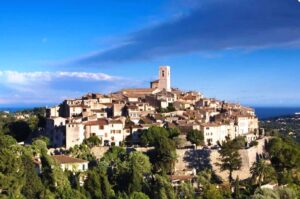
One of the most famous perched villages on the Riviera is St Paul de Vence. It’s within easy reach of Nice for a lovely day out, and what’s more, it’s very near the location of one of the most outstanding art museums in France, the Fondation Maeght. Not far from the Fondation Maeght is the village of Vence (not to be confused with St Paul de Vence!), in the hinterland of Nice, in the direction of Grasse. This village is famous for being the location of the Chapelle du Rosaire (Chapel of the Rosary), decorated by Henri Matisse, and recognised as one of his most outstanding masterpieces. Aside from the many enticing attractions in this part of the Riviera, the dramatic landscape alone is described by many as the highlight of their Riviera trip.
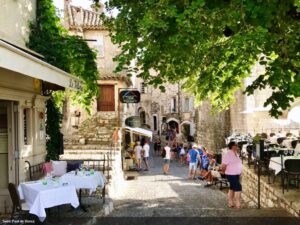
If a visitor to the Côte d’Azur knows the name of only one village in that region, it would likely be Saint Paul de Vence, one of the oldest medieval towns on the Riviera. This beautiful, perched village is about 20 kms from Nice. As well as driving, you can also catch the train from Nice Ville to Cagnes-sur-Mer and then a bus from there up to Le Taude bus stop in Saint Paul, all of which takes a little over 45 mins. Alternatively, a Lignes d’Azur bus goes from Albert 1er Verdun stop in Nice to the airport and change there for another bus to Le Taude stop at Saint Paul. This takes around an hour or so. There’s also a tram that you can take from Jean Medecin stop in Nice to Grand Arenas Nice stop and change there for a bus up to Le Taude, Saint Paul. Sounds complicated, but it’s actually quite simple. The public transport system is also very economical, and whichever you choose, it’ll cost from AUD$ 5 – $10, max. All the modes of transport are very accustomed to visitors heading up to Saint Paul, so don’t hesitate to ask anyone, as well, of course, the Nice Tourist Office. There’s also a Tourism Information Office at 2, rue Grande in Saint Paul. Up until 2011 Saint Paul de Vence was officially known simply as Saint-Paul, and is usually still called that by locals and regular visitors to the area.
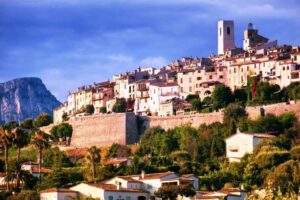
The medieval village is perched on top of a small elliptical hill surrounded by a high wall built in 1538 by Francois l Valois, King of France, who was on the throne from 1515 to 1547. In the 2nd half of the 19th century, the village’s inhabitants had to buy the surrounding walls to protect them from destruction.
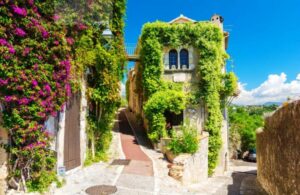
There’s a wonderful panoramic view of the whole area, and as the village lies just a few kilometres from the sea, you can see the coast between Cagnes-sur-Mer and Antibes, while to the north-west, you can see the snow-capped peaks of the Alpes Maritimes. Given its location, it was an obvious location for erecting a fortress during the Middle Ages. Many of the buildings of the village date back to those times as well as the 16th and 17th centuries.
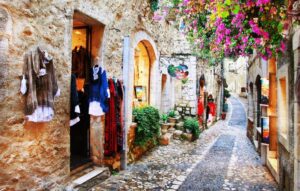
The village itself is not so famous for its countless tourist attractions, as simply a great destination in itself. Stroll along the main street, rue Grande, which leads from the entrance at the north gate (Porte de Vence) to the end of the village, where the cemetery is located just behind the southern gate. Along the way, you’ll pass charming little galleries, shops, restaurants and many art studios. One of the most photographed attractions is the impressive fountain in Place de la Grande Fontaine, which dates back to the Middle Ages.
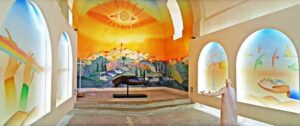
At the highest point in the village there was once a château, but unfortunately, today only a small building is left in which the Hotel de Ville is located. Right next to it stands a church from the 14th century which was raised to collegiate status (Collégiale de la Conversion-de-Saint-Paul) in the 17th century. Nearby is the former Chapelle des Penitents Blancs (Chapel of the White Penitents) from the 17th century, which was restored and decorated at the beginning of the 21st century by the Belgian artist, Jean-Michel Folon. The Chapelle now carries his name. Entry is about 4€.
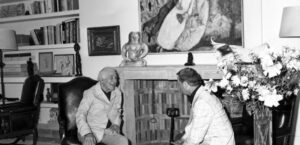
Saint Paul has long been a mecca for artists who have been coming here since the 1920s, among them Picasso, Chagall, Dufy and Matisse. Chagall lived in Saint Paul for 19 years and is buried in the local cemetery. The village is well-known today for its modern and contemporary art museums and galleries, such as the outstanding Fondation Maeght nearby, and for the 17th century Saint Charles-Saint Claude chapel, which was decorated with murals by French artist Paul Conte in 2012-13.
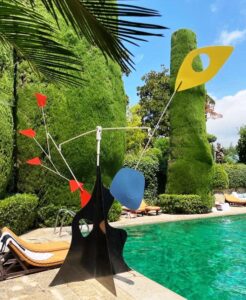
For decades, the village has been a haven for the famous, mostly due to the hotel located in front of the walls, La Colombe d’Or, whose former guests included Jean-Paul Sartre and Pablo Picasso. During the 1960s, the village was frequented by French actors Yves Montand, Simone Signoret and Lino Ventura, as well as poet Jacques Prévert. Other famous faces that regularly visited St Paul included Greta Garbo, Sophia Loren and Catherine Deneuve. American writer James Baldwin lived there for 17 years until his death in 1987, as did British actor Donald Pleasence until his death in 1995. Bill Wyman of the Rolling Stones has a home there. Both Chagall and the Maeghts, the couple who founded the nearby Fondation Maeght, are buried in the town cemetery.
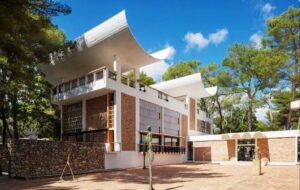
Near Saint Paul de Vence is one of the great attractions of the Riviera for art lovers, the Fondation Maeght, dedicated to modern and contemporary art. A private museum, it has one of the most famous collections in the world. It’s 1.50 kms out of town, around a 10 min. pleasant walk, or take a bus from the village, which takes around 8 – 9 mins. or so. If you decide to walk, take the Chemin Sainte-Claire to the Fondation, and along the way you’ll see 3 chapels and the Convent of the Dominican Sisters, not to mention the magnificent views of the village.
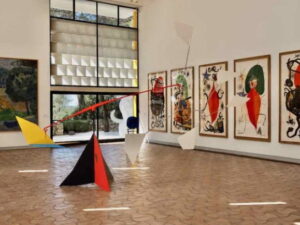
Some of the biggest names in 20th century European sculpture, including Georges Braque, Joan Miró and Alberto Giacometti, came together to help create La Fondation Maeght, which has become the country’s most important art foundation, and is among the world’s leading cultural institutions. It was established by Aimé and Marguerite Maeght, a visionary couple who were publishers and art dealers, and who represented, and were friends with, some of the most important artist of the era, including Braque, Miró and Giacometti, Alexander Calder, Fernand Leger, Marc Chagall, and many others.
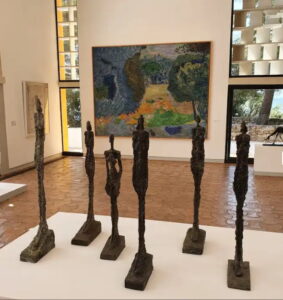
The Fondation was opened on 26 July 1964 by legendary Culture Minister André Malraux, a close friend of the Maeghts. It was France’s first private art institution and was modelled on American institutions such as the Solomon R. Guggenheim Foundation, the Barnes Collection and the Phillips Collection, which the couple had visited during their frequent trips to the US in the 1950s.
The Maeghts went to Josep Lluis Sert, the Spanish architect from Barcelona, who was one of the most celebrated architects of his era. He had worked in Paris for Le Corbusier for a year in 1930 and again from 1937 – 39, designing the Spanish Republic’s pavilion at the Paris Exposition of 1937. He called on his close artist friends, Pablo Picasso, Alexander Calder and fellow Catalan Joan Miró, for the artistic content of the building. Picasso’s contribution was ‘Guernica’—now at the Museo Reina Sofia in Madrid.
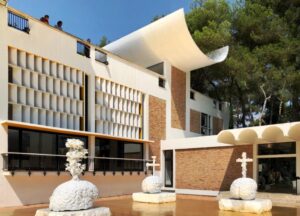
Sert’s design project for the Fondation Maeght in St Paul was more than an architect-client relationship, saying that they were partners in the discovery of modern art. Aimé Maeght had seen Sert’s vast and impressive studio he had designed for his friend Joan Miró, in Palma de Mallorca in the 1950s, and admired its sculpture-like architecture. He was convinced that the architect would be ideal for the creation of what was to be the first private foundation dedicated to the visual arts in Europe.
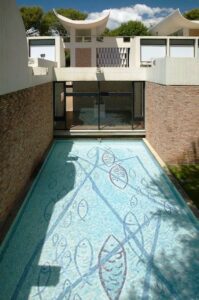
The Fondation’s collection includes works by many of the most important 20th century artists, including Jean Arp, Pierre Bonnard, Georges Braque, Alexander Calder, Marc Chagall, Sam Francis, Alberto Giacometti, Wassily Kandinsky, Ellsworth Kelly, Fernand Leger, Anne Madden and Joan Miró, among numerous others. The museum is now home to approx. 13,000 objects. It recently celebrated its 60th anniversary with a new expansion that added over 465 sq.m., without disturbing any of Sert’s original architecture.
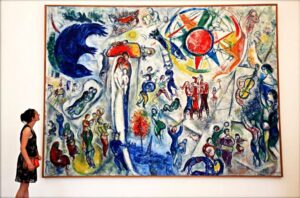
The Fondation has an extensive reference library used by students, researchers, art historians and curators, as well as books produced by Aimé Maeght in collaboration with a number of the original artists whose work the Fondation displayed from its opening. There’s also a regular program of temporary exhibitions, dance events, concerts, films, workshops and theatrical performances.
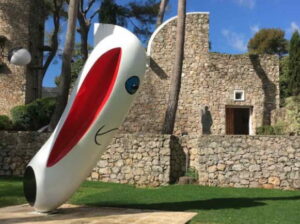
We especially like the sculpture garden, which has a number of monumental works by Miro, Calder, Braque. Barbara Hepworth and others, that sit well in the landscape. Also check out the courtyards, terraces and patios for many other works, such as the Miró Labyrinth, Braque pool, and the Giacometti Courtyard—and don’t forget to visit the shop, which has a great range of posters, reproductions, fashion and accessories, books, catalogues, stationery and gifts. After all that, and before setting off for your next destination, you’ll need some refreshment. In the shade of the Aleppo pines is the café-restaurant, Sous les Pins, which is also open for dinner during July and August, offering gourmet cuisine. The restaurant is a branch of Les Agitateurs in Nice, which has a one star Michelin rating. The Fondation is open every day from 10.00am.
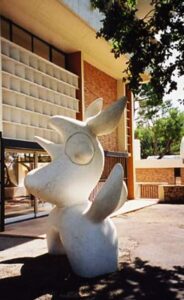
From Fondation Maeght across to Vence is less than 6 kms., which takes around 12 mins. by car or by bus, but you need to walk to Cagnes-sur-Mer, to bus stop Les Fumerates, which takes around 9 mins. and then it’s an 8 min. bus ride to Vence. From 1st July to 30 Sept. there is a “Maeght-Matisse” navette (shuttle bus), which runs from Tuesday to Saturday, 5 times a day. Its route is from the Fondation Maeght, to Saint-Paul de Vence, Grand Jardin, then across to the Matisse’s Chapelle du Rosaire in Vence. Easy.
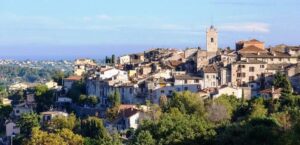
The village of Vence was originally a Roman town called Vintium, of which some vestiges and inscriptions still exist, an important bishopric from 439 up to the French Revolution, and the fiefdom of the Villeneuve family in the Middle Ages. It is surrounded by its 13th century walls, and within the walls you will see numerous monuments and buildings, including medieval houses, that have been well preserved. Five entry gates still remain, 2 from the 13th century, 2 from the 15th century, and one from the 18th century. This last one was built so that the bishop of Vence, Monseigneur Pisani de la Gaude, could arrive directly at his palace’s door without having to get out of his carriage.
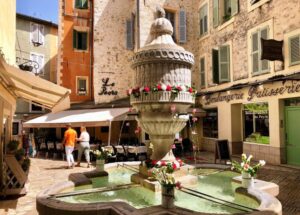
There are around 20 fountains, one of which, the Fontaine du Peyra, is a classified historic monument. Every year, during the month of May, the fountains are honoured with floral decorations and a musical parade as part of the “Fête des Fontaines.” The historic centre, with its narrow streets, its medieval and Renaissance houses, and various squares, has not changed over the centuries. In the middle stands the very pretty Romanesque cathedral dating from the 11th century, and the Saint Accolade Tower, built in the 12th century.
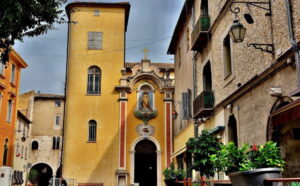
The cathedral houses the marble sarcophagus of St Veran, the bishop of Vence dating from the 6th century and which serves as the altar. You can also admire a beautiful 16th century altarpiece, copper busts, an ensemble of statues in coloured timbers, and a mosaic by Marc Chagall. Today, Vence is relatively small, compared to the more famous Saint Paul de Vence, and has retained the charm of a Provençal village.
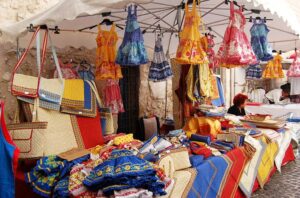
There are daily markets at Place du Grand Jardin selling fresh, local produce with a range that varies from fresh fruit and vegetables to pastries, local honey, and beautiful flowers. On Tuesdays at Place Marechal Juin the market there focuses on fashion and accessories, such as beach bags and cotton scarves, in typical Provencal prints and warm, Mediterranean colours. Wednesday is the day for antiques, brocantes, and 2nd hand books. On Fridays you can visit both Place du Grand Jardin and Place Marechal Juin for a clothing, accessories and food, and Saturday is food market day, with organic and locally produced products.
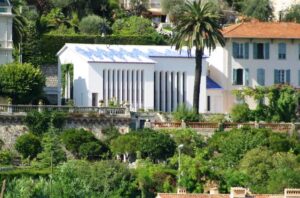
However, the main reason most people visit Vence is the Chapelle du Rosaire. From 1948 to 1951, Matisse drew the plans of the building and all the details of the decoration: stained glass ceramics, stalls and religious iconography. For first-time visitors, it sometimes comes as a surprise to see how small, and some think, unprepossessing, but many more see also how elegantly simple the Chapel is.

It’s an interesting story how the whole project came about. In 1941, Matisse, who lived most of the year in Nice, develop cancer and underwent surgery. During his long recovery, he was particularly helped by a young part-time nurse Monique Bourgeois, who had answered his advertisement seeking “a young and pretty nurse.” Matisse asked her to pose for him, which she did for several drawings and paintings. In 1943, Monique entered the Dominican convent in Vence, and became Sister Jacques-Marie. Matisse eventually bought a house at Vence, not far from the convent and moved there from Nice in 1943 to escape the threat of wartime bombardment. Sister Jacques-Marie visited him and told him of the plans the Dominicans had to build a chapel beside the girls’ high school which they operated in Venice. She asked Matisse if he would help with the design of the chapel, which he readily agreed to do.
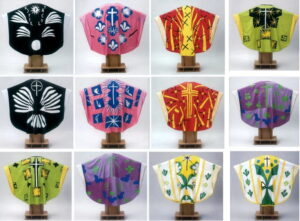
Helped by Father Marie-Alain Couturier in close collaboration with architect August Perret and master glazier Paul Bony, Matisse started working on the project at the age of 77. He spent more than 4 years working on the chapel, its architecture, stained-glass windows, interior murals and ceramics, liturgical furnishings and the priests’ vestments. Matisse and Sister Jacques-Marie remained lifelong friends.
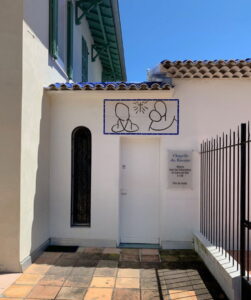
The chapel is built on a hillside and is entered by descending a flight of stairs. The building is an L shape, 15m long x 6m wide. The shorter section was for the nuns who lived and taught at the school, while the longer, larger segment is for the students and townspeople. The altar is situated in the centre of the space and facing the two naves.

The white walls, floor and the ceiling contrast with the stained glass windows, which each day allow the daylight to penetrate through. The stained glass windows are composed of 3 colours: yellow (the light of the sun and of God), green (nature) and blue (the Mediterranean sky). Three large paintings, engraved on white ceramic, decorate the walls of the chapel. Only the reflection of the stained glass windows project colour on the 3 compositions on the walls: Saint Dominique, The Virgin Mary and Child, and the Stations of the Cross.
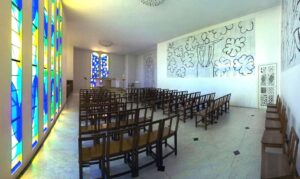
A gallery, exhibiting the initial plans of the chapel, as well as the chasubles designed by Matisse, is open in the north wing of the chapel of the Rosaire. The Chapel is open to the public Monday – Thursday, and Saturday. It’s closed on Friday and Sunday, although visitors are welcome to attend Mass on Sundays at 10.00am. Check though with the Nice Tourist Office that this information is still correct.
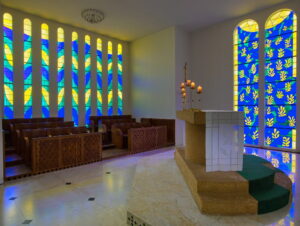
“This work has taken me four years of exclusive and diligent work, and it is the result of my entire working life. Despite all its imperfections, I consider it to be my masterpiece.” Henri Matisse.
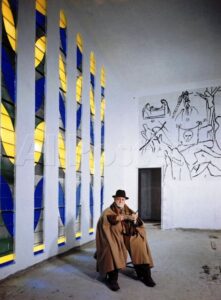
“I started with the secular, and now in the evening of my life, I naturally end with the divine.” Henri Matisse.
There are so many wonderful attractions along the Riviera, and using Nice as a base for a few days, it’s easy to explore many of them. Those here are just a couple of examples.
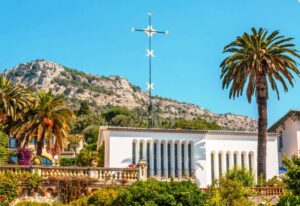


Thanks Cheryl,
I missed seeing St Paul de Vence last year . Another for my list for next year .
Hi Lois,
St Paul de Vence is an absolute Must See if you’re in that part of the country, and as I said in the story, it’s not hard to get to. The problem is though, that there are quite a lot of Must Sees in the area–which is great, as it means there’s always something new to explore, as well as old favourites!
Glad you liked the story.
Cheers, Cheryl
Hi Cheryl,
I found this absolutely fascinating as I did not know anything about the art history of the area. The detail is wonderful and you would need to spend quite some time there to appreciate it. Thank you.
Diane Hogan
Hi Diane,
That’s what makes this part of the country so rewarding–there’s this entirely different, other world, so near to the action on the coast. After all the years (dar I say, decades!), we’ve been visiting the Cote d’Azur, each time we still discover places we’ve not been to before, which we love, since you can never say you’ve seen it all!
Cheers, Cheryl